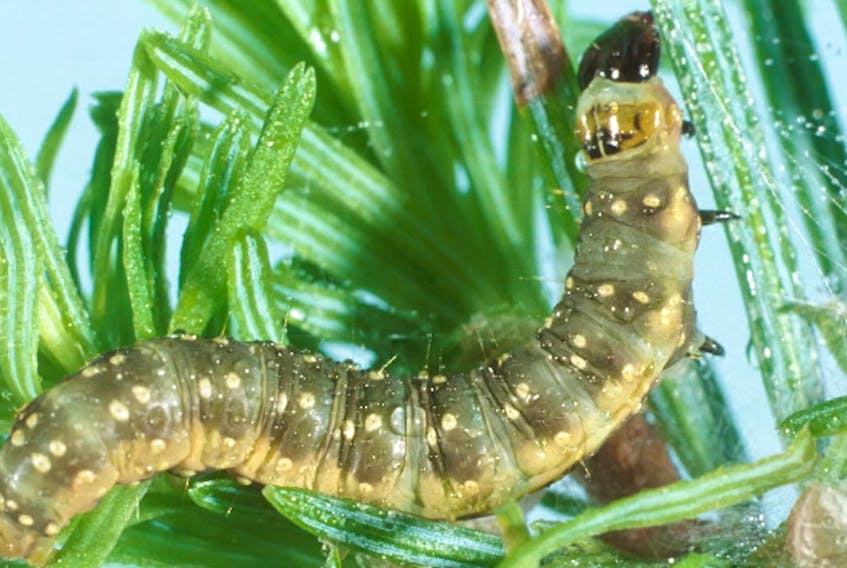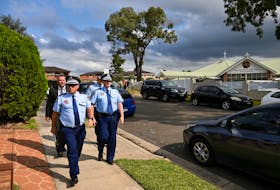Budworm, hemlock looper, balsam fir sawfly — all species the provincial and federal governments keep a close eye on here.
The federal government recently released its annual “State of Canada’s Forests” report, showing Newfoundland and Labrador recorded 85,921 hectares defoliated by insects and beetle-killed trees. The count is provided each year to the feds and is based on the most recent year’s data (in this case, 2015).
But this latest federal report appeared to be alarmingly higher than the 12,033 hectares recorded just a year earlier (2014 data results).
When The Telegram followed up on the jump, it was told there had been a mistake. The 12,033 hectares stated should actually have been 100,689 hectares. The Government of Canada has been notified, according to a provincial rep. There is no alarming year-over-year jump in insect damage.
That said, Newfoundland and Labrador must remain vigilant and manage insect spread and forest damage wherever possible, The Telegram was told, given the potential financial consequences of an outbreak.
Look at spruce budworm. The insect eats tree needles. And while it’s long been found here in controlled numbers, it occasionally cycles into an outbreak, leaving evergreen forests with patches of rusty, damaged trees and other patches of dead trees.
“The last outbreak we had in this province lasted from 1972 right through to 1985. During that period, about 90 per cent of the spruce fir forest on the island was affected and we lost about 50 million cubic metres of wood, which was equivalent to about a 25-year wood supply back at that time,” said Dan Lavigne, supervisor of forest protection in the Department of Fisheries and Land Resources.
Outbreaks of budworm have tended to be cyclical, coming every 30 or 40 years, to varying degrees. An outbreak occurs when natural controls on the insect — such as temperature and natural predators — aren’t enough to keep the insect numbers down. The population reaches a threshold, then the numbers overwhelm the available controls and rapidly multiply.
The budworm count in Labrador started to tick up last year in particular, but Lavigne said the more recent counts have come down. It is being carefully watched, especially given there has been an increase in budworm numbers ongoing in other eastern provinces.
“If you go back to the 1970s when budworm started to rise here in Newfoundland and Labrador, we saw the same increasing trend in other parts of eastern Canada prior to that happening,” Lavigne said.
“We’re certainly very concerned about what’s happening with budworm in other parts of eastern Canada right now.”
Scientists here try to quickly identify and quantify any budworm outbreak, or potential outbreak, to allow for interventions like insecticide spraying, with the hope of minimizing damage and reducing the reach. In 2016, as the CBC reported, New Brunswick sprayed 80,000 hectares of forest with BTK, targeting the rising spruce budworm count, and efforts to manage the pest have continued this year.
In order to know what’s happening in the province’s forest as the years go by, Lavigne said, the province places pheromone traps to catch budworm moths. The traps emit a scent, much like a female moth ready to mate. By number of male moths captured, scientists can get an indication of the number of budworms in the area.
“It’s a really good tool, especially when populations are low,” Lavigne said.
The province also uses branch samples to verify where budworms are established. Actually taking branches from trees to check for budworm at different life stages, the activity tends to be more targeted and used where increasing numbers of budworm are suggested or of particular concern.
New budworm populations can show up at any time, given the significant distances they can migrate. In the 1970s, flights of budworm were tracked by airplane from New Brunswick to Newfoundland’s west coast. Driven by temperature, Lavigne said, moths at an unexpected time suggests new migrations.
Started here by the provincial government and championed now by the Canadian Forest Service, a citizen-science program called Budworm Tracker is now feeding in information to help the work, but also to help ongoing study throughout the eastern provinces — meant to provide a better understanding of the budworm cycles and movements.
The program essentially provides pheromone traps to volunteers. These volunteers check the traps once or twice a week and provide their findings to the project leaders. This comes in addition to the government-set traps.
Research scientist Eric Moise, with the Canadian Forest Service in Corner Brook, said about 50 traps were set as part of the program this year and follow-up work was done in a number of areas.
“As we continue on with the research program, as we potentially move into more outbreak numbers, we’ll always be looking to add traps to sort of fill in the gaps of where we don’t have budworm-tracker citizen scientists at the moment,” Moise said, adding that anyone interested can find out more online at budwormtracker.ca.









